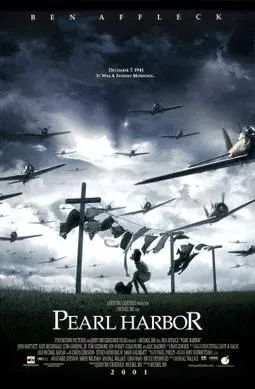Historical accuracy of Pearl Harbor

Historical accuracy of Pearl Harbor

Characters
Captain Rafe McCawley
Rafe is a fictional protagonist created for the film. His experiences, including fighting in the Eagle Squadron, surviving the attack, and flying in the Doolittle Raid, do not represent a real historical person.
Captain Danny Walker
Danny is a fictional protagonist and Rafe's best friend. His central role in the love triangle, the defense during the attack, and the Doolittle Raid are entirely fictional creations for the plot.
Nurse Evelyn Johnson
Evelyn is a fictional character representing the nurses present at Pearl Harbor. Her specific romantic storyline with Rafe and Danny is the core fictional element of the movie.
Lieutenant Colonel James Doolittle
Doolittle was the real leader of the famed 1942 raid on Japan. The film accurately portrays his leadership of this historical mission, but fictionalizes the participation of the main characters (Rafe/Danny).
President Franklin D. Roosevelt
Roosevelt was the real US President. The film depicts his leadership role accurately, though specific scenes, like dramatically forcing himself to stand, are likely embellished for cinematic effect.
Admiral Husband E. Kimmel
Kimmel was the actual Commander-in-Chief of the Pacific Fleet at the time of the attack. The film portrays his real position and the context of the command situation leading up to the attack.
More characters
Admiral Isoroku Yamamoto
Yamamoto was the real Japanese Marshal Admiral who conceived the Pearl Harbor attack. His portrayal as the strategic mind behind the Japanese operation is historically accurate.
Commander Minoru Genda
Genda was a key real-life planner of the Pearl Harbor attack under Yamamoto. The film accurately includes him in his historical role during the planning phases.
Petty Officer Dorie Miller
Dorie Miller was a real Messman Third Class who heroically manned an anti-aircraft gun during the attack despite having no training and racial restrictions limiting his combat role. His actions are accurately depicted.
Captain Thurman
Captain Thurman is a fictional character likely created to represent aspects of US Naval Intelligence and the communication/analysis challenges prior to the attack.
Sergeant Earl Sistern
Earl is a fictional character representing the ground crews and mechanics working at the airfields during the attack.
Lt. Red Winkle
Red is a fictional pilot character, part of the protagonists' squadron, serving largely as comic relief.
Lt. Gooz Wood
Gooz is another fictional pilot within the main characters' friend group.
Nurse Betty Bayer
Betty is a fictional nurse character, part of Evelyn's circle of friends.
Nurse Martha
Martha is another fictional nurse character representing the women serving at Pearl Harbor.
Nurse Sandra
Sandra is another fictional nurse character within Evelyn's group.
Story
The attack on Pearl Harbor
The film accurately depicts the surprise attack on Pearl Harbor by the Japanese, including the date, the general sequence of events, and the devastation inflicted on the US Pacific Fleet. The attack itself is the core historical event and is portrayed relatively faithfully.
The heroism of the US military
The film highlights the heroism and bravery of US military personnel during the attack. While acts of heroism certainly occurred, the film tends to overemphasize individual heroism and downplay the overall chaos and confusion of the situation. It leans towards a romanticized view.
The love triangle between the main characters
The love triangle between the two pilots and the nurse is a fictional construct added for dramatic effect. It serves as a central plot element, but it is not based on real relationships.
The portrayal of the Japanese attack as a 'sneak attack'
The film portrays the attack as a 'sneak attack,' which is a common perspective. However, some historians argue that while the attack was a surprise, the US had some indications of potential Japanese aggression.
The portrayal of the aftermath of the attack
The film shows the immediate aftermath of the attack, including the damage to the fleet and the loss of life. The shock and grief experienced by the survivors and the nation are portrayed with some sensitivity.
The depiction of the 'day of infamy' speech
President Roosevelt's 'day of infamy' speech is referenced in the film, which is a historically significant moment. The speech's impact on mobilizing the nation for war is acknowledged.
The portrayal of the attack on Hickam Field
The film depicts attacks on other military installations beyond the naval base, including Hickam Field. While Hickam Field was attacked, the film may exaggerate the extent of the damage or the specific details of the assault for dramatic purposes.
Setting
The depiction of Japanese planning and motivations
The film offers a simplified portrayal of the Japanese planning and motivations behind the attack. While it acknowledges the Japanese perspective, it doesn't delve deeply into the complex political and strategic factors that led to the attack. It simplifies the Japanese perspective.
The depiction of the US military's preparedness
The film suggests a lack of preparedness on the part of the US military, which is partly true. However, the degree of unpreparedness is debated by historians, and the film likely oversimplifies the complexities of the situation and existing warnings. It's a complex historical issue.
The portrayal of the US public's reaction
The film suggests the attack galvanized the US public and unified them in their resolve to enter the war. While this is generally true, the complexities of public opinion and the debates surrounding involvement in the war are not fully explored. It simplifies public sentiment.
